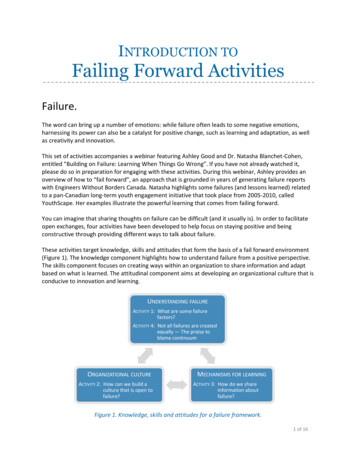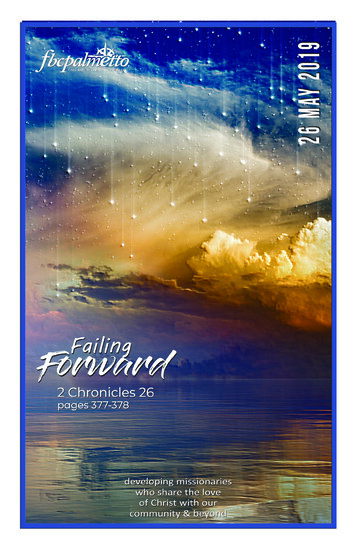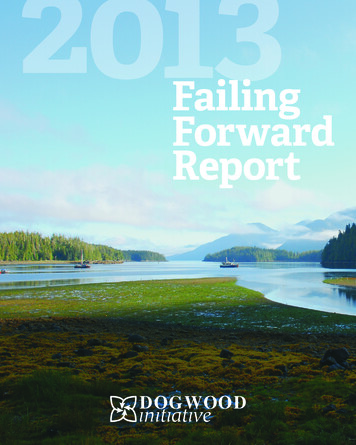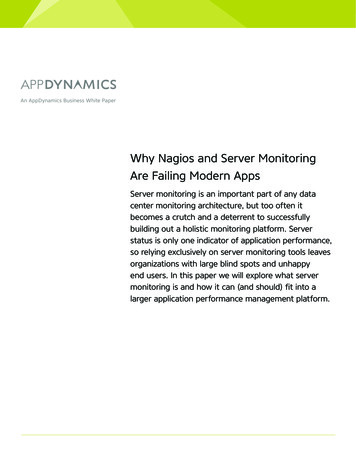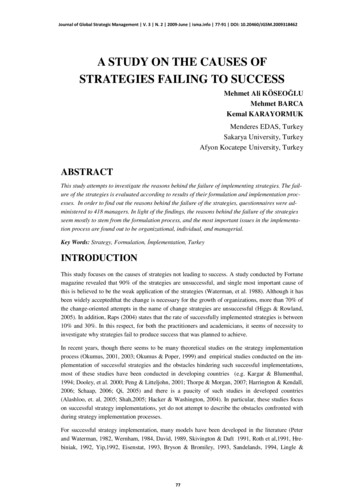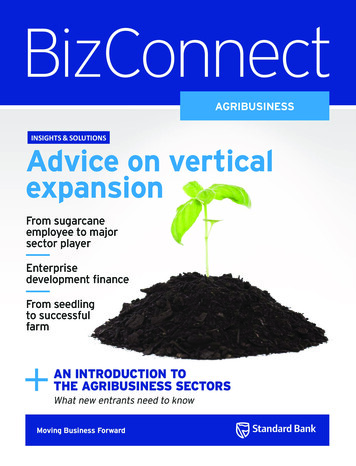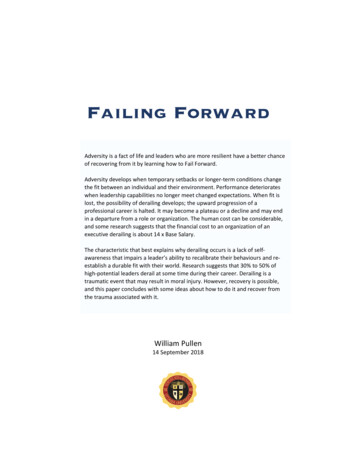
Transcription
Failing ForwardAdversity is a fact of life and leaders who are more resilient have a better chanceof recovering from it by learning how to Fail Forward.Adversity develops when temporary setbacks or longer-term conditions changethe fit between an individual and their environment. Performance deteriorateswhen leadership capabilities no longer meet changed expectations. When fit islost, the possibility of derailing develops; the upward progression of aprofessional career is halted. It may become a plateau or a decline and may endin a departure from a role or organization. The human cost can be considerable,and some research suggests that the financial cost to an organization of anexecutive derailing is about 14 x Base Salary.The characteristic that best explains why derailing occurs is a lack of selfawareness that impairs a leader’s ability to recalibrate their behaviours and reestablish a durable fit with their world. Research suggests that 30% to 50% ofhigh-potential leaders derail at some time during their career. Derailing is atraumatic event that may result in moral injury. However, recovery is possible,and this paper concludes with some ideas about how to do it and recover fromthe trauma associated with it.William Pullen14 September 2018
Table of ContentsIntroduction .3Context: The Arc of a Career .3Part A: Adversity and Resilience . 5The Adversity Spectrum .5A Leader’s Response.5The Resilient Leader .6Leadership Concerns .6When to Respond .7Immediate Response to Setbacks: Find and Fix the Root Cause .7Maintain Momentum: Pivot, Side-Step or Push Through Adverse Conditions .8Leading during Setbacks and Adverse Conditions .8Leadership Presence.9A Leader’s Personal Actions . 10Concluding Thoughts . 11Part B: Derailing . 12Derailing Happens . 12Career Themes Leading to Derailing . 12Career Progression and Derailing . 13What Causes Derailment? . 13Derailing is Preventable. 14Concluding Thoughts . 15Part C: Recovery from the Trauma of Derailing . 16Derailing as Moral Injury . 16Recovery from Trauma . 17Phase 1 – Finding Safety & Stability . 17Phase 2 – Making Sense of the Experience, Finding a new normal. 18Phase 3 – Reconnection, Repair and Integration . 18Good Recovery Practice . 19When to seek professional help . 19Manage your Narrative . 20Concluding Thoughts . 20William Pullen - 14 September 2018ÓUniversity of Ottawa 20182
Failing ForwardIntroductionSenior public servants in leadership roles are typically at, or beyond, the mid-point of their career. They havearrived at this point because of demonstrated professional or technical proficiency and, usually, significantsupervisory or managerial experience. To mangle a phrase used by Warren Bennis, they have learned how todo things right, and are now challenged to do the right thing.In a perfect world, a leadership career unfolds as a smooth uninterrupted progression of successfulexperiences at increasingly greater levels of responsibility until leaders reach an apex and transition to adifferent way of life. But, this trajectory that rarely happens. There are speed-bumps, off-ramps andobstacles that must be navigated. Instead, a career is more like a series of Knights moves in Chess - a zig-zagpattern of different experiences that carry a leader upward.It is a fact that adverse events occur in every career and they alter its trajectory. The zig may be a promotionto a new role and the zag may be a move to a different field. And often an adverse event occurs, or acondition develops that interrupts this pattern. This paper offers thoughts on the nature of adversity and itsconsequences for resilience with the idea of helping leaders to understand the experience as a learningopportunity. The chances of future career success can be improved by learning how to Fail Forward.Context: The Arc of a CareerAdversity occurs within the context of a career and it would be useful to have a way to describe the arc andits trajectory. Consider the diagram below:Careers are not destinations, but rather journeys with a past, a present and a future. They are an arc of aperson’s lifeline. The journey is punctuated by events, some good and some bad, that offer lessons on how todo things right, or do the right thing. These are marker events - the orange shapes along the red career arc inthe diagram above.William Pullen - 14 September 2018ÓUniversity of Ottawa 20183
Over time, the arc becomes a leader’s track record that describes the breadth and depth of their experience,including successes or failures. It extends into the present where a leader is defined by reputation, based inpart on their track record, but also on their character and leadership presence as it is perceived by those whowork with them. It extends into the future as a leadership brand – the implicit potential value that a leaderoffers to bring to a new situation, which may be a movement upward or laterally.Adversity occurs from circumstance or through neglected development. An adverse event may appearsuddenly that off-balances and sets a leader on their back foot. Or, they may find they cannot respondsuccessfully with what they have in their toolbox, or because their energy is depleted and they lack thewillpower to persevere. The nature of adversity and resilience is discussed in Part AAs obstacles or difficult situations develop, a leader may realize that what they have in their leadershiprepertoire may be insufficient for the situation they are in. In the words of Marshall Goldsmith, “what got youhere, won’t get you there.”When this happens, the ‘fit’ between an individual and the rolethey perform deteriorates. If fit is lost, and having ignored oravoided opportunities for personal development, leaders mayfind themselves at a loss as to how to respond successfully.Nothing seems to work for them and performancedeteriorates. In these situations, derailing occurs. Thisphenomenon will be discussed more fully in Part B. Recoveryfrom the trauma of derailing is discussed in Part CWilliam Pullen - 14 September 2018ÓUniversity of Ottawa 2018DerailingWhen a manager who was expected to gohigher in the organization and who wasjudged to have the ability to do so is fired,demoted, or plateaued below expectedlevels of achievement.Lombardo & McCauley (1988)4
Part A: Adversity and ResilienceResilience is the ability to recover from adversity. It is a personal capacity to deal well with daily speedbumpsas well as handling life-changing events. This first part of Failing Forward talks about the nature of adversity,the precursor situation that forms the context for resilience. It looks at it through two lenses: the leader as aresilient individual dealing with adversity and the leader of an organization coping with it.The Adversity SpectrumThe term adversity covers a range of situations. There are temporary setbacks, adverse conditions andchronic suffering. Each demand something slightly different from a leader as an individual and one in chargeof others.A setback is a single event or distinct series of events that impedes forward progress, either as a person or anorganization. Setbacks are usually one-time, one-of-a-kind occurrences. Not making the short-list for apromotion, the departure of a key member of your management team, or a sudden change in programfunding would all be setbacks. The shock of a negative event has not defeated you but has caused you to pullback and regroup.An adverse condition is an ongoing unfavourable situation that is harder to work through. Working with abad boss for any length of time can create a serious adverse condition. Poor relationships with, say, theMinister’s office or a key stakeholder, may make sustained progress painful. Long-standing internal conflictcan cause morale to decline and momentum can be lost. Serious adverse conditions can cause derailing andlead to organizational failure.Adverse conditions can become chronic. Long-standing adversity is suffering and can cause permanentdistress. It may impose spiritual, moral, emotional, and physical harm that causes significant personaltrauma. Suffering marks people and recovery from it is a long and painful process.A Leader’s ResponseAs you might expect, setbacks and adverse conditions require different responses from leaders.A setback often needs a quick and specific response. It’s as if something suddenly appeared in your path. Youstop and find another way to get where you want to go. If the setback is significant, it may take someconcerted effort and skill to keep the organization on track and moving beyond whatever has happened. Theeffects of setbacks, however, are limited in time: once dealt with, you can move on.Adversity is more like a long drive in bad winter weather: you’ll need a steady focus on traffic and the road’scondition until the journey is over. Your concentration is on getting everyone safely to the end of thejourney. That’s what leaders do: keep things moving steadily forward through difficulty and bring the rest ofthe organization along.William Pullen - 14 September 2018ÓUniversity of Ottawa 20185
The Resilient LeaderLeaders who recover quickly from personal or professional difficulties typically are well grounded. That is,they have a strong sense of who they are, comfort with what that means, and confidence in their ability toexert influence on events even if it is only minor. They have a well-formed stable identity and see events incontext. They are level-headed and use patience, tolerance, and humour to deal with adversity.Resilient leaders are action-oriented and know the value of momentum toward their goals even if it is onlythe smallest of steps. They don’t get stuck. They use prior experience in dealing with difficulties to confront acurrent challenge. They are adaptable and can convert lessons from the past into effective responses to thepresent.Resilient leaders are glass half-full people. Unlike pessimists who see negative events as personal, pervasiveand permanent, resilient leaders see them as transient, specific, and impersonal. They explain things in apositive way and add energy to the situation. They have a realistic and well-founded faith in their ability todeal with things. They are also well-connected. They have a network of strong relationships to draw on thatcan help them rebound and recover.Resilient leaders know themselves. They are aware of their strengths and weaknesses and know their blindspots and over-done strengths. Much of this insight is
Failing Forward Introduction Senior public servants in leadership roles are typically at, or beyond, the mid-point of their career. They have arrived at this point because of demonstrated professional or technical proficiency and, usually, significant supervisory or managerial experience. To mangle a phrase used by Warren Bennis, they have learned how to do things right, and are now challenged .
